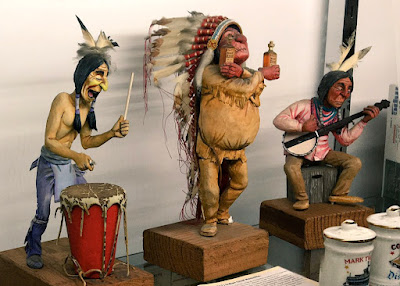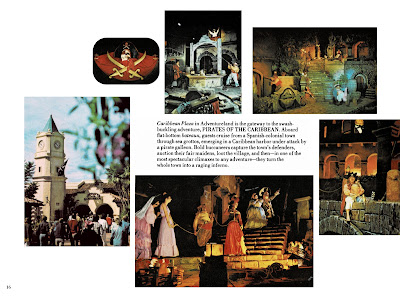A Lot of Marc Davis Indians
The mere fact that, in 2025, there's an expressed preference for the term American Indian by some Native American members of various tribes in this country, when the term Native American seemed like the right nomenclature by general consensus for decades, gives a layperson like myself (with some, not much, Native American blood in my veins) pause before wading into observations on this topic. What's considered respectful today may not be so tomorrow, and it's less likely that I could stay even halfway "accurate" without looking things up repeatedly. I try to. Usually.
I've always thought all the art of Marc Davis should be accessible to the general public (in the same way as should the art of Norman Rockwell) and can't now say, "except his race-based caricatures." I also wouldn't, even if tempted, just post a bunch concept art along those lines and just add, "Marc Davis, 1968" The internet needs more than that now. I understand why.
I also think I understand why Marc Davis, based on the very limited amount of time my friend Ross Plesset and I were able to spend interviewing him and his wife Alice (just once, in 1999), as we looked at most of his Western River Expedition art, chose not to comment very much on his depictions of American Indians in the 1960s. I asked if he had been compelled by anyone else to change any of the 1968 art that he revised in 1974 to minimize the number of Indians in his ride concepts, and he simply said no. It is a fact, though, that by 1974 the ride plan included far fewer Indians than were depicted in the totality of the 1968 plans.
This stuff I bring up not just because it makes no sense to ignore it, but also because Marc Davis is culturally relevant and will probably remain so for a long time to come. He was a key figure in the content of both the Walt Disney Company's animated films and Disney's theme parks. Davis created the character Maleficent, animated and defined the modern look of the character Tinker Bell and took a dominant role in developing attractions like the Jungle Cruise, Pirates of the Caribbean, the Haunted Mansion and several others. He was also one of just a handful of people on Walt Disney's staff whose talent was openly praised by the boss.
The Walt Disney Company shifted its approach to a lot of race-centric things when I was just a baby in 1969. That was the first year when a new Disneyland attraction, in this case the Haunted Mansion, opened with a front line operating cast of both black and white employees. 1970 was not just the year of The AristoCats, with a Siamese cat who played the piano with chopsticks, it was also the year that the Walt Disney World Preview Center opened in Lake Buena Vista, Florida. Two of the first fourteen women hired by WDW were black (the twelve others white) and all were in the group promotional photos for the Preview Center. Three years prior, Disneyland had yet to put a black cast member in a front line tour guide role. That finally happened in 1968. So 1968 to 1971 best represents the time period during which the Disney company pivoted considerably on matters of race representation in their workforce. They were arguably ahead of the curve in American industry.
That was also the time period during which Marc Davis produced the art seen here and WED Enterprises artists sculpted models based on that art. Some of it has not been previously reproduced online or in published documents to my knowledge. High quality versions of the art are very rare. Davis created some stereotypical depictions of Indians but was also assiduous in his research of other cultures, of their manner of dress, their architecture and their art. He was not coming at other cultures from a place of malice or with an intent to degrade. He was trying to infuse his work with maximum humor, and that left other considerations in the backseat at times. You can see that the features of some characters being exaggerated is sometimes the only quality of certain Davis drawings that fall into the category, but he regularly exaggerated the features of white people in his art also. He was an animator at heart, and this informed most of his work. Caricaturizing was one of his most essential skills.
Something Davis drew that I first found to be an extremely funny concept was that of a American Indian woman playing a trumpet as part of a medicine show ... in the same way that seeing Deborah Kerr as a Scottish noble picking up and blowing a horn in Casino Royale was funny. The humor being that both were completely unexpected. A key difference being that in doing so, while both characters are playing against type, the only type that an American Indian woman could be in the context of American popular culture would be that of someone whose ancestors and peers had their way of life largely destroyed and then marginalized by European immigrants. In this regard, using her as even an accomplished trumpet player for this scene feels wrong to me now.
Whether one uses terms like racist or racially insensitive or stereotypical in conjunction with looking at the art in 2025 feels less relevant to me than just thinking about how the Walt Disney Company presents, addresses, obscures, hides or ignores things along these lines. While you would almost need to deliberately search for this particular Marc Davis art in 2025 to encounter it, that's not true of everything. It's still possible for Disney film viewers and Disney theme park visitors to find content that depicts American Indians in unfavorable ways with minimal explanation ... in ways that no prominent entertainment company would knowingly depict black people in the 21st century.
Image sources: Anonymous, Mike Cozart, Walt Disney Company, Marc Davis in His Own Words by Christopher Merritt and Pete Docter (2019)
w y w y w y w y w y w y w y w y w y w
w y w y w y w y w y w y w y w y w y w
w y w y w y w y w y w y w y w y w y w
w y w y w y w y w y w y w y w y w y w
w y w y w y w y w y w y w y w y w y w
w y w y w y w y w y w y w y w y w y w
w y w y w y w y w y w y w y w y w y w
w y w y w y w y w y w y w y w y w y w
w y w y w y w y w y w y w y w y w y w
w y w y w y w y w y w y w y w y w y w
w y w y w y w y w y w y w y w y w y w
w y w y w y w y w y w y w y w y w y w























































